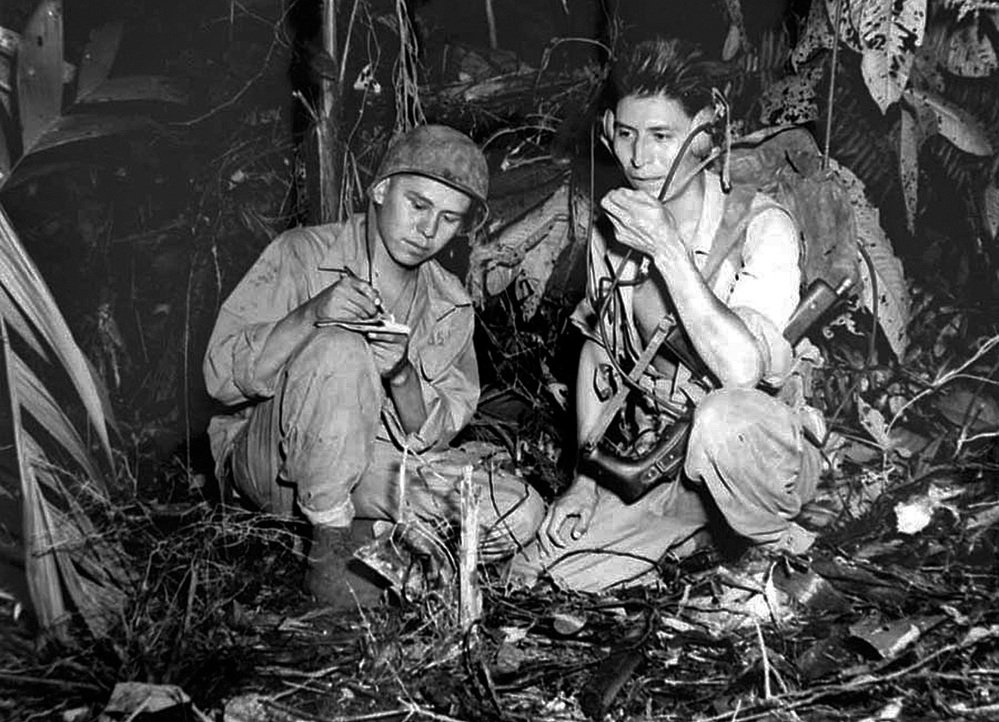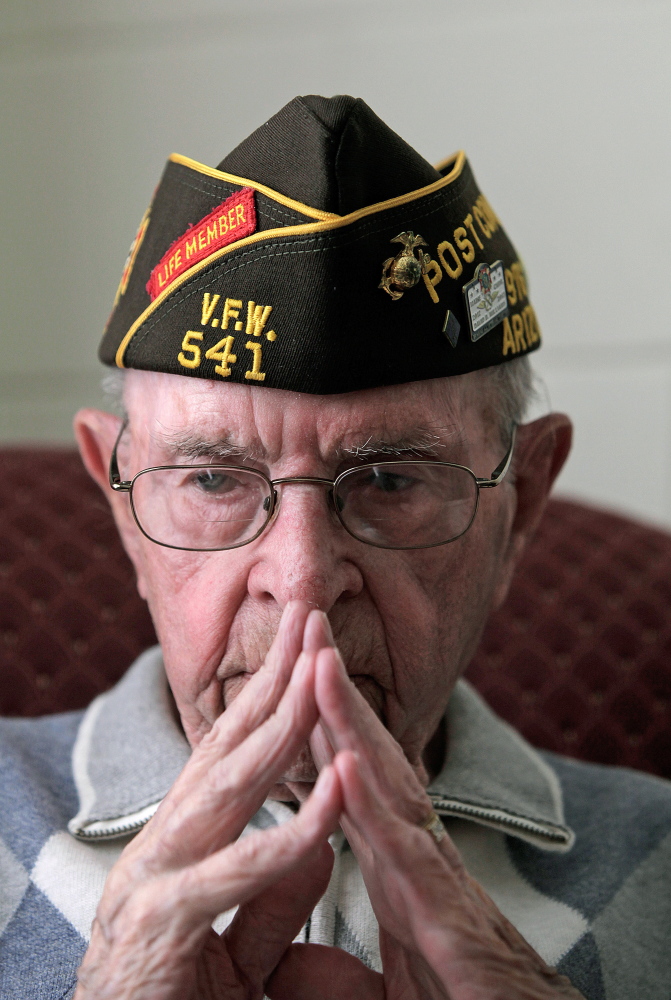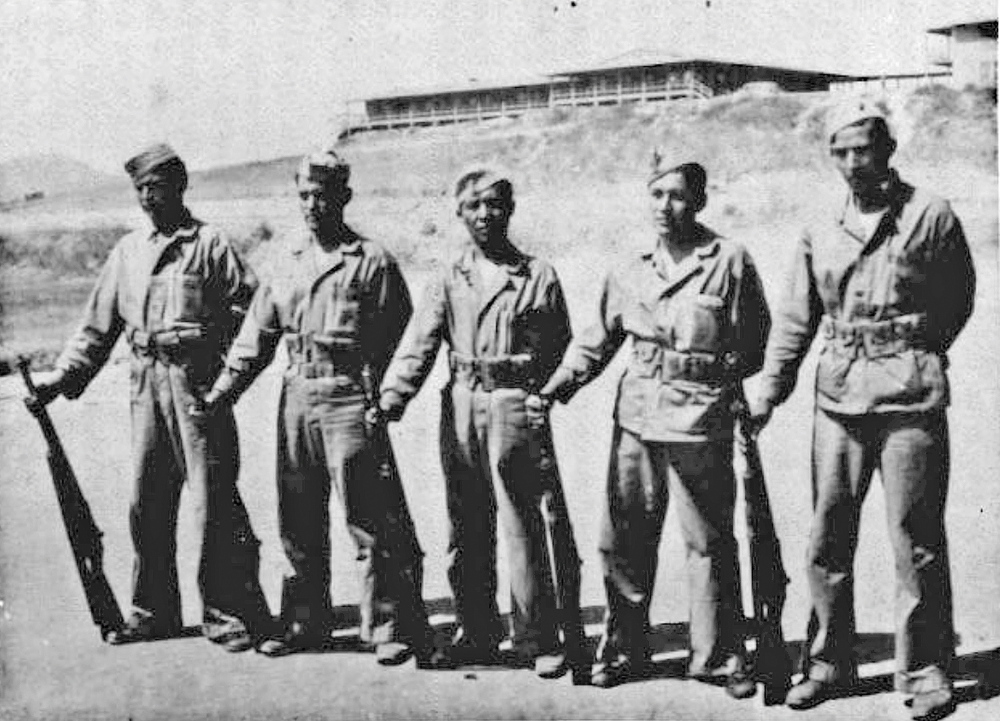John McLeod was a 20-year old Marine from Maine when he became privy to one of the best-kept secrets of World War II.
In the spring of 1945, McLeod, who grew up in Portland, was a private in the communications unit with the 7th Marine Regiment, 1st Division. He was stationed on the island of Okinawa during one of the bloodiest campaigns of the war — the 82-day battle between Allied and Japanese forces. More than 65,000 American troops were killed, wounded or missing in action in Okinawa, with the Japanese casualties even higher.
McLeod worked side by side with a man named Rex Kontz, a Navajo from Fort Defiance, Ariz.
“Rex and I worked out in the field,” said McLeod, 91. “But we had a canvas shelter to protect the radio and code machine.”
He remembers listening as Kontz talked on the radio to troops who were dodging artillery fire miles away, not understanding a word being said.
“It was gibberish to me,” he said.
That gibberish helped win the war.
Kontz was a Navajo code talker, one of an estimated 400 Navajo who served in communications units during World War II, sending tactical messages in a top secret code they had developed themselves.
They worked in tandem: one code talker on the front line, his counterpart back at headquarters.
In Okinawa, Kontz was at headquarters.
“He would get a message from another Navajo (code talker) that was important,” McLeod said, “and he would write it down in English and I would take it from him and give it to the commanding officer.”
Kontz was a quiet guy, completely focused on the job, McLeod said. The two didn’t spend much time chatting.
“He wore those earphones all the time,” said McLeod.
Kontz and 29 other members of the Navajo tribe, most of them teenagers, were recruited by the Marines in 1942, guinea pigs in a plan concocted by a man named Philip Johnston.
Johnston, whose parents were missionaries, grew up on the Navajo reservation in Arizona. He approached the military with the idea of using Navajo speakers to develop and send code, as other Native Americans had done on a smaller scale during World War I.
The Navajo language is unwritten. When spoken, the pitch and tone of voice can completely change the meaning of a word. The Navajo recruits had the ingredients for an indecipherable code.
Now they needed a foolproof recipe.
The 30 men (one eventually dropped out), working at what became known as the Navajo Code School at Camp Pendleton, in California, came up with a code system that eventually would confound the enemy.
First, they designated specific words in Navajo to represent certain English words frequently used by the military.
“In the Navajo language,” said R.O. Hawthorne, 88, a former code talker and now vice president and chief operating officer of the Navajo Code Talkers Association, “we never had a word for machine gun, fighter plane, battle ship, all those things.”
So a fighter plane, Hawthorne said, was called a hummingbird: in Navajo, the sound is di-he-tih-hi. The code word for battleship was “whale”; for armored vehicle, “turtle.”
Each letter of the alphabet also was represented by a Navajo word.
The code consisted of about 400 terms that each code talker had to commit to memory. Most of the information they would be asked to transmit concerned critical combat intelligence, such as troop movements and fire support.
“It was somewhat difficult,” Hawthorne said, “’cause we weren’t allowed to keep our notes. … At night, when it was time to sleep, we would chose somebody as a partner and rehearse the code.”
The original group of 29 code talkers then began training other Navajo recruits. Code talkers were used in every major battle in the Pacific Theater from 1942 to 1945.
Because the code was so secure, code talkers could use radios and field telephones to transmit messages, a much more rapid and efficient means than sending them by machine.
Their speed and accuracy were astounding. According to several accounts, code talkers at the battle of Iwo Jima delivered more than 800 encrypted messages over a two-day period without a mistake.
It was a code within a code, said Charles Melson, the chief historian of the U.S. Marine Corps.
“Apparently, the Japanese intercepted and recorded their voice conversations,” Melson said. “They knew it was Navajo. But because Navajo is a tonal language, they couldn’t transcribe it, couldn’t make a hard copy for anyone to decipher.”
The code was never broken.
“I like to say that the Navajo code talkers sunk the Rising Sun,” Hawthorne said.
After the war, Rex Kontz went back home to Arizona, where he worked for the Bureau of Indian Affairs and in tribal government. He rarely talked about his military service.
“They were told to keep quiet about it,” said his son, Richard Kontz, who lives in Gallup, N.M. “So he would never talk about it. He said, ‘We’re not supposed to.'”
Kontz died in 1980. The last of the original 29 code talkers, a man named Chester Nez, died in June.
John McLeod, who left the military in 1946, spent most of his career working in machine shops.
The contribution made by the code talkers to the war effort was recognized officially in 1982 when then-President Ronald Reagan declared Aug. 14 National Navajo Code Talkers Day. It’s a day that John McLeod takes to heart.
He didn’t just work alongside Rex Kontz, he said. He kept a constant eye on him. But not the way Hollywood depicted.
“I wasn’t his bodyguard,” he said. Nor was he — or anyone else — ever ordered to shoot a code talker who was in danger of being captured by the enemy.
But keeping Rex Konst safe was a priority.
“I had to watch out for him … protect him if I could,” said McLeod. “Everybody else who was with a Navajo had to do the same thing.”
In the torrential rain and mud, in the heat and horror that was Okinawa in the spring of 1945, a bond formed between the two, one based on deep respect.
“I was honored to serve with him,” McLeod said.
Send questions/comments to the editors.





Success. Please wait for the page to reload. If the page does not reload within 5 seconds, please refresh the page.
Enter your email and password to access comments.
Hi, to comment on stories you must . This profile is in addition to your subscription and website login.
Already have a commenting profile? .
Invalid username/password.
Please check your email to confirm and complete your registration.
Only subscribers are eligible to post comments. Please subscribe or login first for digital access. Here’s why.
Use the form below to reset your password. When you've submitted your account email, we will send an email with a reset code.